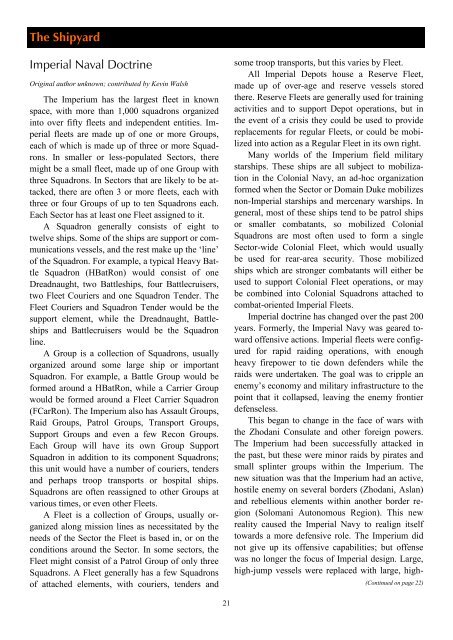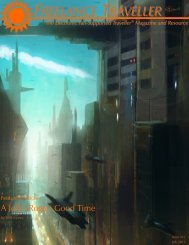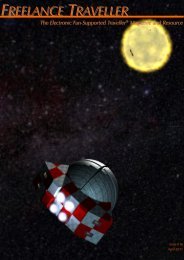ISO A4 format - Freelance Traveller
ISO A4 format - Freelance Traveller
ISO A4 format - Freelance Traveller
Create successful ePaper yourself
Turn your PDF publications into a flip-book with our unique Google optimized e-Paper software.
The Shipyard<br />
Imperial Naval Doctrine<br />
Original author unknown; contributed by Kevin Walsh<br />
The Imperium has the largest fleet in known<br />
space, with more than 1,000 squadrons organized<br />
into over fifty fleets and independent entities. Imperial<br />
fleets are made up of one or more Groups,<br />
each of which is made up of three or more Squadrons.<br />
In smaller or less-populated Sectors, there<br />
might be a small fleet, made up of one Group with<br />
three Squadrons. In Sectors that are likely to be attacked,<br />
there are often 3 or more fleets, each with<br />
three or four Groups of up to ten Squadrons each.<br />
Each Sector has at least one Fleet assigned to it.<br />
A Squadron generally consists of eight to<br />
twelve ships. Some of the ships are support or communications<br />
vessels, and the rest make up the ‗line‘<br />
of the Squadron. For example, a typical Heavy Battle<br />
Squadron (HBatRon) would consist of one<br />
Dreadnaught, two Battleships, four Battlecruisers,<br />
two Fleet Couriers and one Squadron Tender. The<br />
Fleet Couriers and Squadron Tender would be the<br />
support element, while the Dreadnaught, Battleships<br />
and Battlecruisers would be the Squadron<br />
line.<br />
A Group is a collection of Squadrons, usually<br />
organized around some large ship or important<br />
Squadron. For example, a Battle Group would be<br />
formed around a HBatRon, while a Carrier Group<br />
would be formed around a Fleet Carrier Squadron<br />
(FCarRon). The Imperium also has Assault Groups,<br />
Raid Groups, Patrol Groups, Transport Groups,<br />
Support Groups and even a few Recon Groups.<br />
Each Group will have its own Group Support<br />
Squadron in addition to its component Squadrons;<br />
this unit would have a number of couriers, tenders<br />
and perhaps troop transports or hospital ships.<br />
Squadrons are often reassigned to other Groups at<br />
various times, or even other Fleets.<br />
A Fleet is a collection of Groups, usually organized<br />
along mission lines as necessitated by the<br />
needs of the Sector the Fleet is based in, or on the<br />
conditions around the Sector. In some sectors, the<br />
Fleet might consist of a Patrol Group of only three<br />
Squadrons. A Fleet generally has a few Squadrons<br />
of attached elements, with couriers, tenders and<br />
some troop transports, but this varies by Fleet.<br />
All Imperial Depots house a Reserve Fleet,<br />
made up of over-age and reserve vessels stored<br />
there. Reserve Fleets are generally used for training<br />
activities and to support Depot operations, but in<br />
the event of a crisis they could be used to provide<br />
replacements for regular Fleets, or could be mobilized<br />
into action as a Regular Fleet in its own right.<br />
Many worlds of the Imperium field military<br />
starships. These ships are all subject to mobilization<br />
in the Colonial Navy, an ad-hoc organization<br />
formed when the Sector or Domain Duke mobilizes<br />
non-Imperial starships and mercenary warships. In<br />
general, most of these ships tend to be patrol ships<br />
or smaller combatants, so mobilized Colonial<br />
Squadrons are most often used to form a single<br />
Sector-wide Colonial Fleet, which would usually<br />
be used for rear-area security. Those mobilized<br />
ships which are stronger combatants will either be<br />
used to support Colonial Fleet operations, or may<br />
be combined into Colonial Squadrons attached to<br />
combat-oriented Imperial Fleets.<br />
Imperial doctrine has changed over the past 200<br />
years. Formerly, the Imperial Navy was geared toward<br />
offensive actions. Imperial fleets were configured<br />
for rapid raiding operations, with enough<br />
heavy firepower to tie down defenders while the<br />
raids were undertaken. The goal was to cripple an<br />
enemy‘s economy and military infrastructure to the<br />
point that it collapsed, leaving the enemy frontier<br />
defenseless.<br />
This began to change in the face of wars with<br />
the Zhodani Consulate and other foreign powers.<br />
The Imperium had been successfully attacked in<br />
the past, but these were minor raids by pirates and<br />
small splinter groups within the Imperium. The<br />
new situation was that the Imperium had an active,<br />
hostile enemy on several borders (Zhodani, Aslan)<br />
and rebellious elements within another border region<br />
(Solomani Autonomous Region). This new<br />
reality caused the Imperial Navy to realign itself<br />
towards a more defensive role. The Imperium did<br />
not give up its offensive capabilities; but offense<br />
was no longer the focus of Imperial design. Large,<br />
high-jump vessels were replaced with large, high-<br />
(Continued on page 22)<br />
21

















